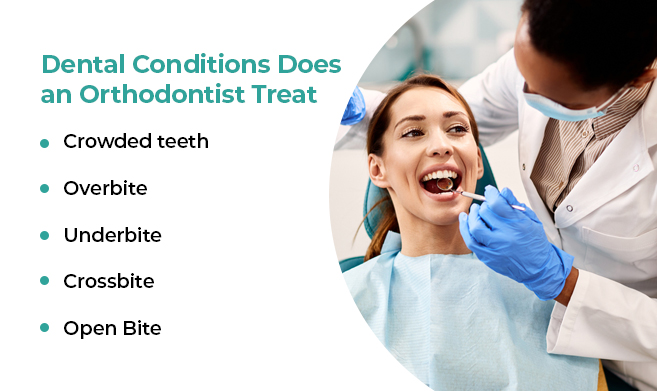A Biased View of Legacy Orthodontics
A Biased View of Legacy Orthodontics
Blog Article
The Ultimate Guide To Legacy Orthodontics
Table of ContentsWhat Does Legacy Orthodontics Do?Everything about Legacy OrthodonticsLegacy Orthodontics Things To Know Before You BuySee This Report about Legacy OrthodonticsWhat Does Legacy Orthodontics Do?
At Advanced Orthodontics, we offer people with a alternative therapy experience. Furthermore, we use adjustable treatment routines, adaptable payment alternatives and a fun, delightful experience. leesburg orthodontics. Telephone call ( 480) 357-4900 today to find out more and timetable a visit.An orthodontist is a dental practitioner trained to detect, protect against, and deal with teeth and jaw abnormalities. Orthodontists function with people of all ages, from kids to grownups.
Malocclusion, or misaligned teeth, can result in oral concerns, consisting of tooth decay, gum illness, and challenging or excruciating chewing. Not everyone is born with straight teeth. If you have a negative bite or big spaces between your teeth, you might want to seek advice from a dental professional focusing on orthodontic care.
The Buzz on Legacy Orthodontics
( Photo Credit Rating: DigitalVision/Getty Images) Orthodontists use taken care of and removable oral devices, like dental braces, retainers, and bands, to alter the position of teeth in your mouth. Orthodontic therapy is for dental abnormalities, consisting of: Misaligned teethBite problems, like an overbite or an underbiteCrowded teeth or teeth that are as well much apartJaw misalignmentThe goal of orthodontic therapy is to enhance your bite.
While you might believe of orthodontists as mainly for kids or teenagers that need braces, they can fix dental troubles at any kind of age. Orthodontists attend university, oral school, and orthodontic college.
, yet not all dental experts are orthodontists. They focus on 2 areas: How to properly and securely relocate teeth How to appropriately assist growth in the teeth, jaw, and faceOnce an orthodontist has finished training, they have the alternative to end up being board certified.
Things about Legacy Orthodontics
Malocclusion leads to tooth congestion, a misshapen jaw, or irregular bite patterns. Malocclusion is normally treated with: Your orthodontist attaches metal, ceramic, or plastic square bonds to your teeth.
If you have only minor malocclusion, you might be able to make use of clear braces, called aligners, rather of conventional dental braces (https://www.behance.net/brianmccune). Some individuals require a headwear to aid relocate teeth right into line with pressure from outside the mouth. After braces or aligners, you'll need to use a retainer. A retainer is a personalized device that keeps your teeth in position.
They're most commonly used on kids. They can produce added area in the mouth without having to draw teeth. If you have a major underbite or overbite, you could need orthognathic surgery (also called orthodontic surgical procedure) to extend or reduce your jaw. Orthodontists make use of wires, surgical screws, or plates to support your jaw bone.
You might need to see an orthodontist if you have: Crowding or not enough room for every one of your teethOverbite, when your top teeth come over your bottom teethUnderbite, when your bottom teeth are as well far forwardSpacing or concerns with gapsCrossbite, which is when your top teeth fit behind your base teeth when your mouth is closedOpen bite or an upright gap in between your front bottom and top teethMisplaced midline, when the center of your bottom and top teeth do not line up Dealing with a dental malocclusion can: Make attacking, chewing, and speaking easierImprove the proportion of our face and your total appearanceEase pain from temporomandibular joint disordersSeparate your teeth and make them much easier to clean up, aiding stop dental cavity or dental caries It's often a dentist that first notices misaligned teeth during a regular examination.
Little Known Questions About Legacy Orthodontics.

Throughout your initial orthodontic examination, you'll likely have: An oral examPhotos taken of your face and smileDental X-raysPanoramic (360 degree) X-rays of your face and headImpressions to develop mold and mildews of your teethThese tests will certainly aid your orthodontist understand exactly how to continue with your treatment. braces. An orthodontist is a dental practitioner who's had training to treat your teeth and jaw
Orthodontists may perform surgery, exams,X-rays,and more to assist you obtain a more comfy, healthier smile. An orthodontist is concentrated on your bite, so something like a broken tooth would certainly be taken care of by a dental expert. Orthodontists are dental practitioners but not all dental professionals are orthodontists. Orthodontists are focused on your bite, or the method your teeth fit together, and the straightness of your teeth.
Ever questioned how stars always seem to have flawlessly aligned teeth? The answer typically depends on the competent hands of an orthodontist. Yet exactly what does an orthodontist do? Orthodontists are oral professionals who focus on remedying irregularities in the teeth and jaws. Their know-how goes beyond just developing a lovely smile; it expands to improving your total oral health and wellness and function.
Top Guidelines Of Legacy Orthodontics

While braces are the most typically identified orthodontic therapy, orthodontists have a varied toolkit at their disposal. The specific approach chosen depends on the intensity of the instance, the individual's age, and specific choices. These tried-and-true dental braces utilize a system of brackets bonded to the teeth and linked by wires.
Clear aligners, like Invisalign, are a prominent alternative for patients seeking a more discreet therapy option. These removable trays are personalized to gradually move the teeth's position. Headgear may be used combined with dental braces or aligners to apply added targeted pressures, especially for fixing jaw inconsistencies. In cases of narrow jaws, palatal expanders can be utilized to create space for correct tooth placement.
Report this page